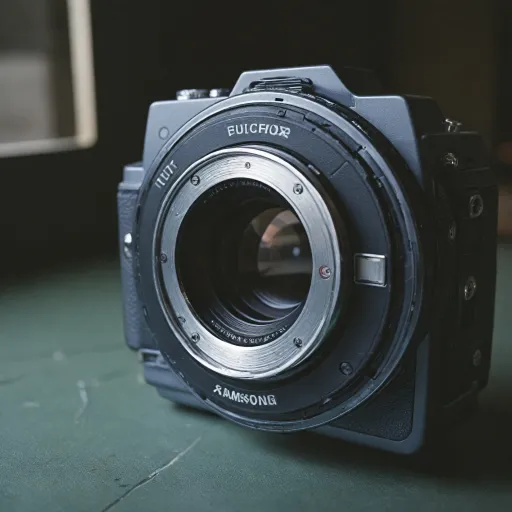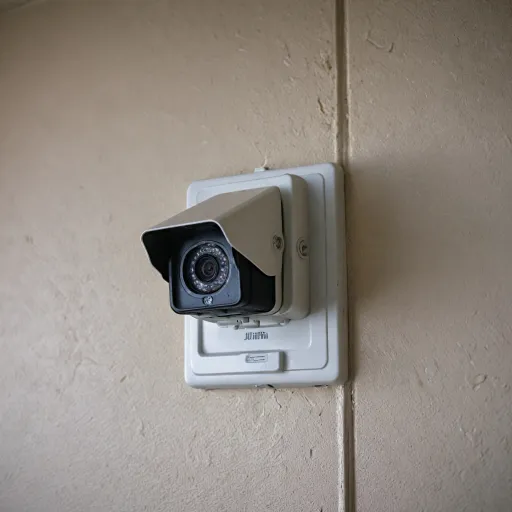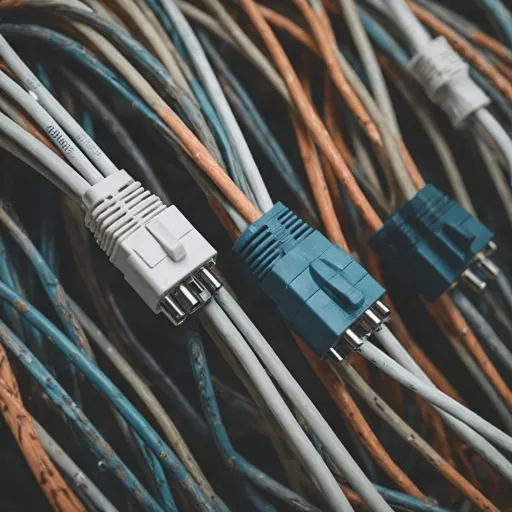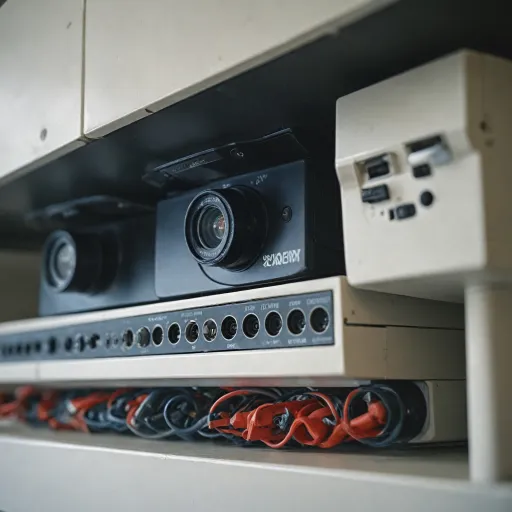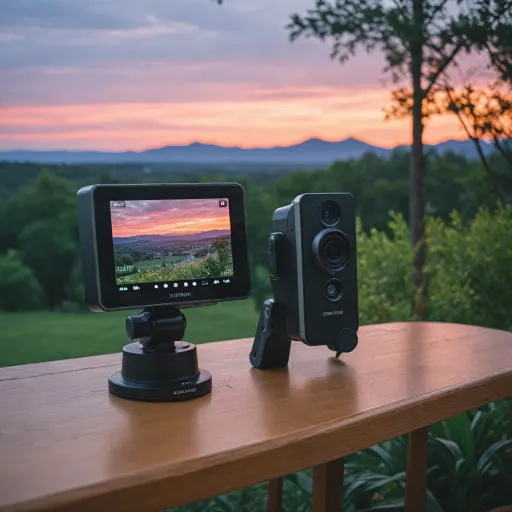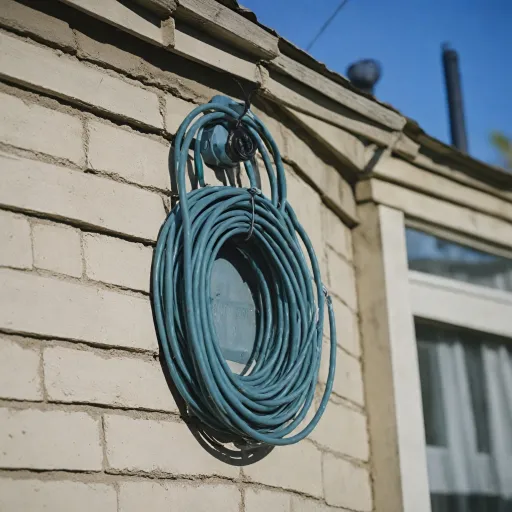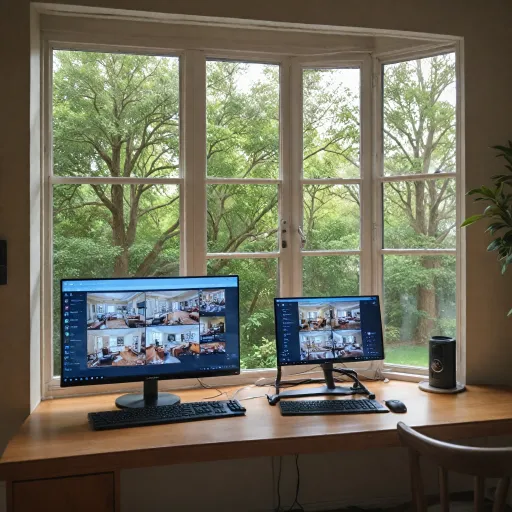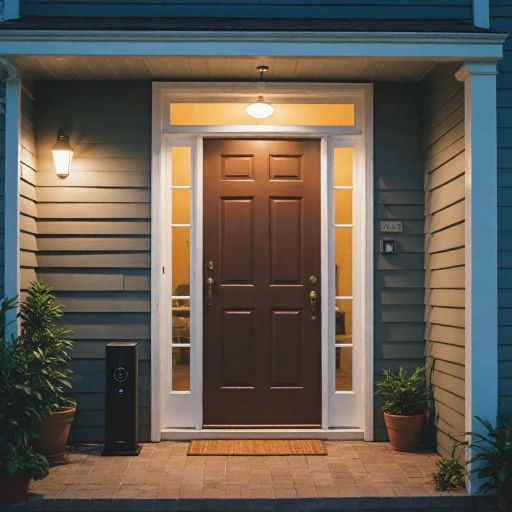
Understanding the basics of surveillance camera and monitor systems
What Makes Up a Home Surveillance System?
When considering home security, understanding the components of a surveillance system is essential. At its core, a typical setup includes cameras, monitors, and the necessary connectors and cables to link everything together. These systems are designed to provide real time video monitoring, helping you keep an eye on your property whether you’re at home or away.
Types of Cameras and Monitors
There are several types of security cameras and monitors available for home use. CCTV cameras, wireless security cameras, and PTZ cameras (pan-tilt-zoom) each offer unique advantages. For instance, wireless security cameras are easy to install and can be placed almost anywhere, while PTZ cameras allow you to adjust the view remotely. Monitors come in various forms, including LCD screens and specialized CCTV monitors, which display live camera feeds for ongoing surveillance.
- Camera systems: Can be wired or wireless, with options for HD video and night vision.
- Monitors: Range from small test monitors to large screens for multi-camera viewing.
- Connectors and cables: HDMI and BNC cables are common for connecting cameras to monitors, ensuring a stable video signal.
How Surveillance Systems Work Together
A complete security system integrates cameras, monitors, and connectors to create a seamless monitoring experience. The camera captures footage, which is transmitted via cables or wirelessly to the monitor. Some systems offer cloud storage or local recording, often using micro SD cards. If you’re interested in learning more about choosing the right micro SD card for your security camera, this guide on micro SD cards for security cameras can help you make an informed decision.
Key Considerations for Homeowners
When selecting a camera surveillance system, consider factors like the number of cameras needed, the type of monitoring (live or recorded), and compatibility with your home’s existing security setup. Look for NDAA compliant products if you have business security needs or specific regulatory requirements. Also, think about whether you want a system that’s easy to expand or integrate with smart home devices.
Understanding these basics will help you make sense of the more advanced features and installation tips discussed in the following sections. Whether you’re looking for a simple camera monitor or a full-featured CCTV security system, knowing the fundamentals is the first step toward effective security monitoring at home.
Key features to look for in a ring camera
Essential Capabilities for Effective Home Security
When evaluating a Ring camera for your home, it’s important to focus on features that enhance both security and daily monitoring. The right camera system can make a significant difference in how you protect your property and loved ones. Here’s what to look for:
- Video Quality: Opt for cameras with high-definition (HD) resolution. Clear video is crucial for identifying details in real time, especially in low-light conditions. Many Ring cameras offer 1080p HD video, which is a solid standard for home surveillance.
- Field of View: A wide-angle lens ensures broader coverage. This reduces blind spots and helps you monitor larger areas with fewer cameras.
- Night Vision: Infrared night vision allows for continuous monitoring, even in complete darkness. This is essential for 24/7 security.
- Motion Detection: Advanced motion sensors can alert you to activity, sending notifications to your phone or monitor. Look for adjustable sensitivity to minimize false alarms.
- Two-Way Audio: Built-in microphones and speakers let you communicate with visitors or deter intruders directly through the camera system.
- Connectivity: Wireless security cameras are easier to install and reposition. However, check if your system supports both Wi-Fi and wired options like BNC connectors for flexibility.
- Integration with Monitors: Ensure compatibility with your preferred display, whether it’s an LCD screen, CCTV monitor, or even your smartphone. HDMI and BNC outputs are common for connecting to larger screens or test monitors.
- Storage Options: Some Ring cameras offer cloud storage, while others support local storage via microSD cards. Consider your privacy needs and how you want to access recorded footage.
- Weather Resistance: For outdoor surveillance, choose cameras with weatherproof ratings to withstand rain, dust, and temperature changes.
- Compliance and Security: Look for NDAA compliant devices if you have specific regulatory requirements, especially for business security or camera surveillance in sensitive areas.
For a deeper dive into how Ring cameras function and what sets them apart from other security camera systems, check out this guide on understanding the functionality of Ring cameras.
Comparing Features Across Camera Systems
Not all camera systems are created equal. Some offer PTZ (pan-tilt-zoom) capabilities, allowing you to remotely adjust the camera angle for better coverage. Others may include advanced monitoring features like real-time alerts, integration with other security systems, or compatibility with multiple camera feeds on a single monitor.
- PTZ Cameras: Useful for large properties or business security, PTZ cameras can cover more ground and zoom in on suspicious activity.
- Wireless vs. Wired: Wireless security cameras are easier to install but may be affected by Wi-Fi interference. Wired systems using BNC cables offer more stable connections, especially for larger CCTV camera setups.
- Monitor Compatibility: Make sure your cameras and monitors work seamlessly together. Some systems support multiple camera feeds on one screen, ideal for comprehensive security monitoring.
Choosing the right combination of cameras, monitors, and connectors ensures your security system is both effective and easy to use. The right features will support your daily monitoring needs and provide peace of mind, whether you’re at home or away.
Installation tips for optimal coverage
Positioning Your Ring Camera for Maximum Security
Getting the most out of your Ring camera system starts with smart placement. The goal is to cover entry points and high-traffic areas without leaving blind spots. Place your cameras at least nine feet above the ground, angled slightly downward. This helps capture faces and activity while making it harder for intruders to tamper with your security cameras. For wider coverage, consider PTZ cameras that allow you to pan, tilt, and zoom remotely. If you’re using multiple cameras, ensure their fields of view overlap for seamless surveillance.
Choosing the Right Connections and Monitors
Ring cameras are primarily wireless, but understanding connectors is still important if you’re integrating with other CCTV systems. For traditional setups, BNC cables are common for analog CCTV camera feeds, while HDMI is preferred for connecting to modern LCD or test monitors. Wireless security cameras simplify installation, but make sure your Wi-Fi signal is strong where you plan to mount each camera. For live monitoring, a dedicated camera monitor or a compatible screen can help you keep an eye on your property in real time. Some users opt for a CCTV monitor or use their existing devices as monitors for added flexibility.
Weatherproofing and Power Considerations
Outdoor camera surveillance requires weatherproof models. Check the camera’s IP rating to ensure it can withstand rain and dust. For wireless systems, battery life is key. Place your cameras within range of your Wi-Fi router and consider solar panels or regular charging schedules. For wired systems, plan your cable runs carefully—keep cables out of sight to deter tampering and use conduit where possible for extra protection.
Optimizing Your Security System for Daily Monitoring
- Test your camera feeds after installation to confirm clear video and audio.
- Adjust motion detection zones to minimize false alerts from passing cars or animals.
- Use the Ring app or compatible monitors for real time monitoring and quick access to recorded footage.
- For business security, consider integrating your Ring cameras with other CCTV security systems for broader coverage.
Keep in mind that some advanced features, like extended video storage or professional monitoring, may require a subscription. For a breakdown of what’s included and how it impacts your security monitoring, check out this guide to Ring camera subscription costs.
Privacy concerns and how to address them
Protecting Your Privacy with Ring Cameras
When adding a Ring camera or any surveillance system to your home, privacy should be a top priority. These devices, while enhancing security, also raise important questions about how your video footage is handled and who can access your camera feeds. Here’s what you need to know to keep your monitoring both effective and respectful of privacy.
Key Privacy Considerations
- Data Encryption: Modern Ring cameras and other security cameras use encryption to protect your video and audio data. Always check that your camera system supports end-to-end encryption, especially if you’re using wireless security cameras or transmitting video over Wi-Fi networks.
- Access Controls: Set strong, unique passwords for your camera system and regularly update them. Most camera monitors and surveillance systems allow you to manage who can view live or recorded footage. Limit access to trusted users only.
- Cloud Storage: Many Ring cameras store footage in the cloud. Review the provider’s privacy policy to understand how your data is stored, who can access it, and how long it’s retained. Some systems also offer local storage options for added control.
- Location of Cameras: Position cameras and monitors to avoid capturing footage from neighboring properties or private spaces inside your home. This helps you comply with privacy laws and maintain good relationships with neighbors.
- Firmware Updates: Regularly update your camera and monitor firmware. Updates often include security patches that protect against vulnerabilities in your surveillance system.
Addressing Privacy Concerns
- Notifications: Most camera systems, including Ring, allow you to customize notifications. Adjust settings so you’re only alerted to relevant activity, reducing unnecessary monitoring of daily life.
- Privacy Zones: Some security cameras and monitors let you set privacy zones, blocking out areas you don’t want to record. This is especially useful for PTZ cameras and systems with wide-angle lenses.
- Compliance: If you’re using your camera system for business security or in shared spaces, make sure your setup is NDAA compliant and follows local regulations regarding video surveillance and data protection.
Best Practices for Secure Monitoring
- Use secure connectors and cables, such as HDMI or BNC, for wired systems to prevent unauthorized access.
- Choose camera monitors and LCD screens that support secure connections and real-time monitoring without exposing your feeds to the internet unless necessary.
- Regularly review your camera system’s settings and test monitors to ensure everything is functioning as intended.
By following these steps, you can enjoy the benefits of camera surveillance and security monitoring while keeping your personal data safe. Whether you’re using wireless security cameras, PTZ cameras, or a full CCTV camera system, prioritizing privacy will help you get the most out of your investment in home security.
Using your ring camera for daily monitoring
Making the Most of Your Ring Camera for Everyday Security
Once your Ring camera is installed and set up, daily monitoring becomes an essential part of your home security routine. With the right approach, you can use your camera system not just for emergencies, but also for peace of mind and proactive surveillance.
- Real-time alerts: Enable notifications on your mobile device or monitor to receive instant updates when motion is detected. This feature allows you to respond quickly to any unusual activity, whether you’re at home or away.
- Live video feeds: Use the Ring app or a compatible camera monitor to check your camera feeds at any time. This is especially useful for monitoring deliveries, visitors, or checking on pets and children.
- Integrating with other systems: Many Ring cameras can be connected with other security systems, wireless security devices, and even business security solutions. This integration enhances your overall surveillance and monitoring capabilities.
- Using multiple cameras: If you have several cameras, set up zones and customize alerts for each area. This helps you focus on key spots and reduces unnecessary notifications.
- Reviewing footage: Regularly check stored video clips to spot patterns or recurring issues. This can help you identify potential vulnerabilities in your security system or camera placement.
Optimizing Your Monitoring Setup
For the best experience, consider how your monitors and screens are positioned. Whether you use an LCD, CCTV monitor, or a test monitor, ensure it’s easily accessible and provides a clear view of your camera feeds. HDMI and BNC connectors can help you connect your cameras to different types of screens, while wireless options offer flexibility in placement.
PTZ cameras (pan-tilt-zoom) offer advanced monitoring features, allowing you to adjust the camera angle remotely for a broader view. If your system supports it, take advantage of these features for more effective surveillance.
Tips for Consistent Security Monitoring
- Test your camera system and monitors regularly to ensure all components are working correctly.
- Keep your software and firmware updated for the latest security enhancements.
- Make sure your wireless security cameras have a strong signal and your cables (like BNC or HDMI) are securely connected for uninterrupted video.
- Check that your system is NDAA compliant if you have specific regulatory requirements.
By using your Ring camera and monitoring system effectively, you can maintain a high level of security and gain valuable insights into daily activities around your home or business. Consistent monitoring, combined with the right technology, helps you stay one step ahead in protecting your property.
Troubleshooting common issues with ring cameras
Common Problems and Quick Fixes
- Connection Issues: Wireless security cameras like Ring can sometimes lose connection to your Wi-Fi. Make sure your router is close enough to the camera and that there are minimal obstructions. Restarting both the camera and your router often resolves temporary drops in live video feeds.
- Video Quality Problems: If your camera system is showing blurry or delayed video, check your internet speed and the camera’s placement. For wired systems, inspect connectors such as HDMI, BNC, or cables for any loose connections. For wireless models, reducing interference from other devices can help improve real time monitoring.
- Power Supply Concerns: If your Ring camera or cctv camera isn’t powering on, verify the power source and cables. For battery-powered models, ensure the battery is charged. For wired cameras, check the power adapter and connectors.
- App Notifications Not Working: Double-check your app settings to ensure notifications are enabled for your security system. Sometimes, updating the app or your phone’s operating system can resolve notification delays.
- Monitor or Screen Issues: If your lcd or cctv monitor is not displaying camera feeds, confirm that the monitor is set to the correct input (HDMI, BNC, etc.). Test with another screen or test monitors to rule out monitor failure.
Maintaining Reliable Security Monitoring
- Regularly update your Ring camera firmware and app to benefit from the latest security features and bug fixes.
- Clean the camera lens and check for obstructions to maintain clear video surveillance.
- Periodically test your camera system, including ptz cameras and bnc cameras, to ensure all components are working as expected.
- For business security or larger camera systems, consider using ndaa compliant equipment for added peace of mind.
When to Seek Professional Help
If troubleshooting doesn’t resolve the issue, or if your camera surveillance system repeatedly fails, it may be time to contact Ring support or a qualified technician. Persistent problems with connectors, cables, or the camera monitor can sometimes indicate deeper issues within your security cameras or monitoring systems.



